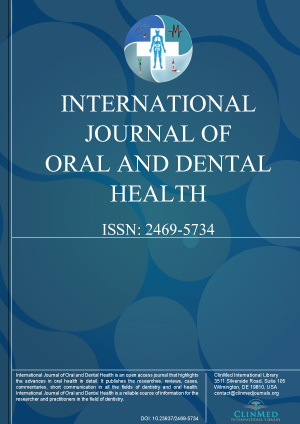Open Access DOI:10.23937/2469-5734/1510093
Cheiloplasty in Functional Aesthetic Treatment for Bilateral Double Lip: Case Report
Taysnara Ismaeley de Andrade, Danilo de Moraes Castanha, Joelma Silva de Andrade, Diogo de Oliveira Sampaio and Carlos Frederico de Farias Batista
Article Type: Case Report | First Published: June 29, 2019
The double lip is a rare and benign developmental alteration characterized by increased lip tissue, specially of the upper lip. Its etiology is linked to congenital factors, such as Ascher Syndrome, or being acquired by labial trauma. The main related complaint is the aesthetic, and the diagnosis is predominantly based on the clinical aspect. The hormonal exams are part of the differential diagnosis. Regarding the treatment, there are several techniques of surgical excision but the elliptical in...
Open Access DOI:10.23937/2469-5734/1510091
Association between Pathogens and Periodontal Status of Chinese Women during Pregnancy and within One Year after Delivery
Zhen Huang, Zhibin Chen, Lu He, Yueqin Sha and Jun Kang
Article Type: Clinical Research Article | First Published: May 29, 2019
The aim of this study is to compare the detection of periodontal pathogens in the oral cavity of pregnant and non-pregnant women in the childbearing age and to understand the influence of pregnancy status on the ecology of periodontal pathogens. Non-stimulated whole saliva samples were collected from a total of 84 pregnant women (including 29 during the first trimester, 29 in the second trimester, 26 at the end of pregnancy), 33 postpartum women, who were chosen randomly. The plaque index (PlI),...
Open Access DOI:10.23937/2469-5734/1510090
Case Report: Molar Intrusion with Temporary Anchorage Device
Israel K, Gonzalez N and Ximena Toledo Pinto
Article Type: Case Report | First Published: May 29, 2019
A clinical case report of the 2 mm. intrusion of tooth 1.6 and the rehabilitation of the space left by the extracted tooth 4.6 with a single implant and crown. Four micro screws were installed in relation to tooth 1.6, two buccal and two in the hard palate. The tooth was intruded in a period of six months with two power chains anchored to cross-shaped micro screws. The chains were replaced every 21 days. The implant to replace tooth 4.6 was also placed and after six months tooth 1.6 was in posit...
Open Access DOI:10.23937/2469-5734/1510089
Treatment of Edentulousness by Combined Implantation and Reduced Dentures: A Case Report
Slavoljub Tomić
Article Type: Case Report | First Published: May 27, 2019
Finding the optimal solution for total numbness, which would satisfy all the principles of the modern dental profession, and thus the patient itself, is still a matter of the skills of a surgeon and prosthetist, but also a compromise with the patient, which should in no way compromise with the postulates of dental implantology. This is a presentation of the care of a 65-year-old patient who appeared in a private dental clinic for the solution of total heartlessness, among which the implant-prost...
Open Access DOI:10.23937/2469-5734/1510088
Assessment of Dental Caries and Oral Health Challenges of School-Age Children in Rhino Camp Refugee Settlements in Arua, Uganda
Robert Kagabo, PhD, MSW, MPH, Tejinder P Singh, BDS, MDS, MPH, Caren J Frost, PhD, MPH and Lisa H Gren, PhD, MSPH
Article Type: Research Article | First Published: May 09, 2019
Oral health remains a global public health concern. Limited available research indicates there is a link among poor oral health, socio-economic status, and other health disparities. However the oral health challenges among refugee children in African refugee camps has had negligible exploratory attention. Two primary schools were selected from Rhino Camp Refugee Settlements in Arua, Uganda. Participants were from only one class at each of the selected schools. This cross-sectional study was comp...
Open Access DOI:10.23937/2469-5734/1510086
Classification of the Methods of Local Anesthesia and Special Features of Vascular-Diffuse Injection
Petrikas AZ, Medvedev DV, Yakupova LA, Efimova OE, Chestnyh EV, Kulikova KV and Sazonova KA
Article Type: Review Article | First Published: April 19, 2019
The main feature of modern injection methods of dental anesthesia is in the local venous spreading of the anesthetic in the near-toothed spongy substance of the bone and dental pulp. The vascular mechanism is controlled by the epinephrine anesthetic solution and patient vegetal system. Spongy dental anesthesia is universal, highly effective, relatively safe, easy to implement and increasingly widespread. Classification proposed by us is the division of injection methods of anesthesia into tradit...
Open Access DOI:10.23937/2469-5734/1510085
Diagnosis, Prevention and Treatment of White Spot Lesions Related to Orthodontics
Sitki Sarper Temel and Burcak Kaya
Article Type: Review Article | First Published: April 05, 2019
The purpose of this review article is to examine the etiology, incidence and classification of white spot lesions in association with their prevention and treatment methods. White spot lesions are opacities that occur by demineralization of enamel under the surface and cause esthetic problems. Orthodontic treatment increases the risk of white spot lesion occurrence by creating areas difficult to clean and prone to plaque accumulation around orthodontic attachments. Therefore, application of suit...

